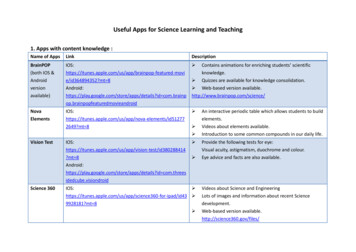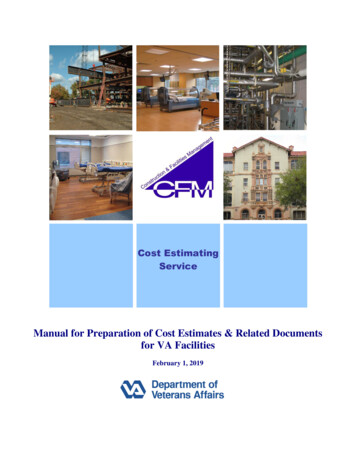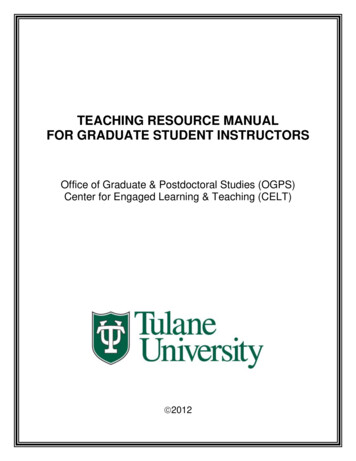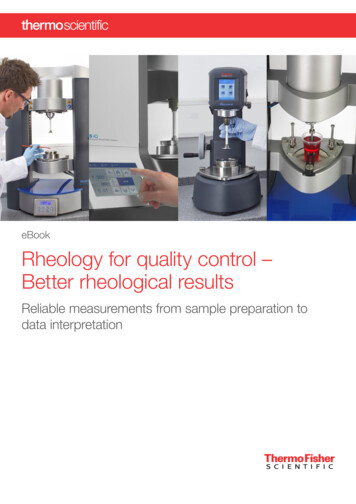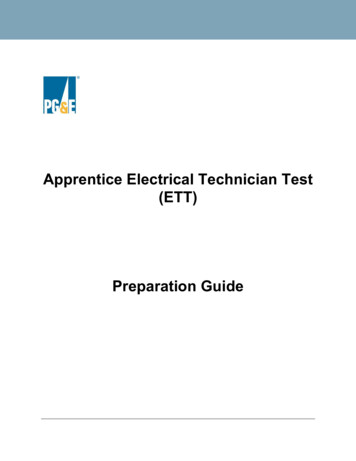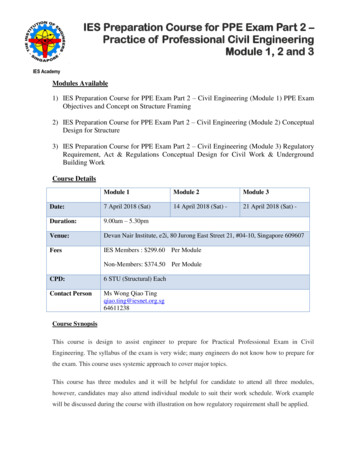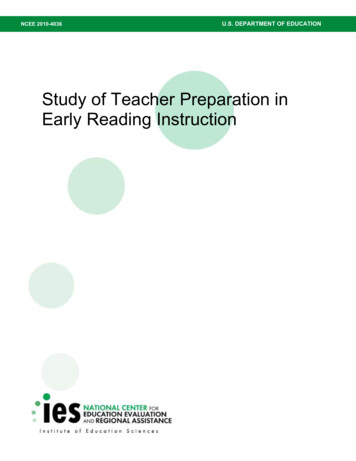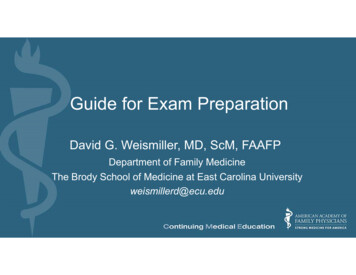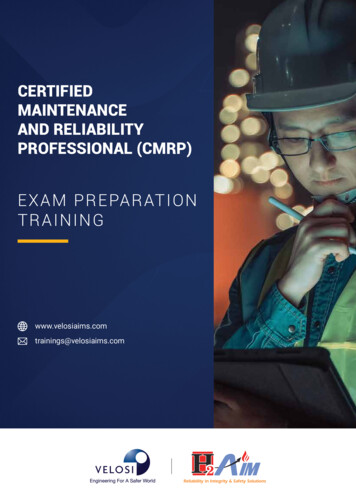
Transcription
Preparation ManualScience of Teaching Reading: (293)Overview and Exam FrameworkSample Selected-Response QuestionsSample Selected-Response Answers and RationalesSample Constructed-Response QuestionCopyright 2020 by Texas Education Agency (TEA). All rights reserved.
Preparation ManualSection 3: Overview and Exam FrameworkScience of Teaching Reading (293)Exam OverviewExam NameScience of Teaching ReadingExam Code293Time5 hoursNumber of Questions90 selected-response questions and 1 constructed-response questionFormatComputer-administered test (CAT)The TExES Science of Teaching Reading (293) exam is designed to assess whether an examinee has the requisiteknowledge and skills that an entry-level educator in this field in Texas public schools must possess. The 90 selectedresponse questions and the 1 constructed-response question are based on the Science of Teaching Reading examframework. Questions on this exam range from Prekindergarten–Grade 6. Your final scaled score will be based onlyon scored questions.The Standards(a)Science of Teaching Reading (STR) Standards. The STR standards identified inthis section are targeted for classroom teachers of early learners (birth through ageeight). The standards address the discipline that deals with the theory and practice ofteaching early reading. The standards inform proper teaching techniques, strategies,teacher actions, teacher judgements, and decisions by taking into considerationtheories of learning, understandings of students and their needs, and thebackgrounds and interests of individual students. The standards are also aligned withthe Texas Prekindergarten Guidelines and Chapter 110 of this title (relating to TexasEssential Knowledge and Skills for English Language Arts and Reading). Thestandards address early reading content knowledge in Prekindergarten–Grade 6,with an emphasis on Prekindergarten–Grade 3, in order to meet the needs of allearly learners and address vertical alignment. Candidates in the following categoriesof classroom teachers will be assessed by the STR standards:(1) Early Childhood: Prekindergarten–Grade 3;(2) Core Subjects with Science of Teaching Reading: Early Childhood–Grade 6;(3) Core Subjects with Science of Teaching Reading: Grades 4–8;(4) English Language Arts and Reading with Science of Teaching Reading: Grades4–8; and(5) English Language Arts and Reading/Social Studies with Science of TeachingReading: Grades 4–8.2
Knowledge of Reading Development Components. Classroom teachers identified insubsection (a) of this section demonstrate understanding of Kindergarten–Grade 6Texas Essential Knowledge and Skills and the Texas Prekindergarten Guidelinespertaining to reading and apply knowledge of developmentally appropriate, researchand evidence-based assessment, and instructional practices to promote students'development of grade level skills within the following components of reading:(1) oral language development;(b)(2) print awareness and alphabet knowledge;(3) phonological and phonemic awareness;(4) phonics (decoding and encoding);(5) reading fluency;(6) vocabulary development;(7) syllabication and morphemic analysis;(8) comprehension of literary text;(9) comprehension of informational text; and(10) beginning strategies and reading comprehension skills.Reading Pedagogy. Classroom teachers identified in subsection (a) of this sectiondemonstrate understanding of the principles of reading instruction and assessmentand use a range of instructional strategies and assessment methods to promotestudents' development of foundational reading skills, including:(1) providing explicit, systematic instruction that is sequential and multimodal (e.g.,sequential lessons, gradual release model, structured literacy);(c)(2) implementing both formal and informal methods of measuring student progressin early reading development;(3) implementing, designing, and executing developmentally appropriate,standards-driven instruction that reflect evidence-based best practices; and(4) acquiring, analyzing, and using background information (familial, cultural,educational, linguistic, and developmental characteristics) to engage allstudents in reading, including students with exceptional needs and Englishlearners.Domains and CompetenciesThe content covered by this exam is organized into broad areas of content called domains. Each domain covers oneor more of the educator standards for this field. Within each domain, the content is further defined by a set ofcompetencies. Each competency is composed of two major parts:3
The competency statement, which broadly defines what an entry-level educator in this field in Texaspublic schools should know and be able to do. The descriptive statements, which describe in greater detail the knowledge and skills eligible for testing.Domain I—Reading PedagogyCompetency 001—(Foundations of the Science of Teaching Reading): Understand foundational concepts, principles, andbest practices related to the science of teaching reading.For example:A. Demonstrate knowledge of scientifically based reading research (e.g., key findings of the NationalReading Panel, the National Early Literacy Panel, the National Literacy Panel for Language MinorityChildren and Youth), including the key research-based components of reading instruction (i.e., phonemicawareness, phonics, fluency, vocabulary, and text comprehension) and the essential roles that orallanguage, writing, and motivation play in promoting reading development for students in prekindergartenthrough grade 3.B. Demonstrate knowledge of the Texas Prekindergarten Guidelines related to reading and the TexasEssential Knowledge and Skills (TEKS) for English Language Arts and Reading (ELAR) (Kindergartenthrough Grade 6).C. Apply knowledge of the interconnected nature of listening, speaking, reading, writing, and thinking byplanning reading instruction that reflects an integrated and recursive model of literacy.D. Demonstrate knowledge of the characteristics of students at various stages of reading development fromlearning to read, including emergent (i.e., pre-reading stage or pre-alphabetic stage), beginning (i.e.,initial reading and decoding stage or partial- to full-alphabetic stage), and transitional (i.e., confirmationand fluency stage or consolidated-alphabetic stage), to reading to learn, including intermediate (i.e.,reading-to-learn-the-new stage) and advanced (i.e., multiple viewpoints stage and construction andreconstruction stage), in order to help inform instructional planning and management of readinginstruction.E. Recognize that decoding and encoding skills are reciprocal and develop synchronously during the earlystages of literacy development, and demonstrate knowledge of the characteristics of students at variousstages of spelling development (e.g., pre-communicative or pre-phonetic, semi-phonetic, phonetic,transitional, conventional).F. Demonstrate knowledge of the interrelationships between the various components of reading and theimportance of promoting students' development of both foundational reading skills and variousdimensions of reading comprehension (e.g., listening comprehension, vocabulary development, literaryanalysis, analysis of informational text, responses to text) at all stages of reading development.G. Recognize the importance of planning and managing reading instruction in ways that not only promotestudents' learning and skill development in reading but also nurture their development as lifelong readersand their self-concept as readers by creating strong associations between reading and feelings ofenjoyment, engagement, and self-efficacy and by promoting increased awareness of their own thoughts,feelings, likes, and dislikes with regard to texts.H. Demonstrate knowledge of key principles of research-based and evidence-based reading instruction,including basing instruction on the standards outlined in the Texas Prekindergarten Guidelines and theTEKS for ELAR (Kindergarten through Grade 6); making instructional decisions based on ongoingassessment results; designing and implementing developmentally appropriate, standards-driveninstruction that reflects evidence-based best practices; and ensuring that reading instruction issystematic, sequential, explicit, and strategic and promotes the prevention of reading difficulties.4
I.Demonstrate knowledge of factors that can affect students' reading development, including the amountof time they spend daily engaged in reading, the amount of screen time they engage in daily, a readingcurriculum that emphasizes the development of productive reading and vocabulary skills (e.g., phonics,structural analysis) rather than overreliance on memorization and context clues and that emphasizes thereading of whole texts rather than worksheets, and the use of culturally responsive instructional practices(e.g., call-and-response strategies).J.Demonstrate knowledge of the importance of using an assets-based approach when acquiring,analyzing, and using background information about students (e.g., familial, cultural, educational,socioeconomic, linguistic, and developmental characteristics) to inform instructional planning and engageall students in reading.K. Demonstrate understanding of the importance of differentiating classroom instruction to address theassessed needs of all students (e.g., students with limited prior experiences with literacy, students withexceptional needs, English learners, students who are experiencing difficulty, students who areperforming above grade level, students who are gifted and talented), including understanding theimportance of being proactive in remediating students' identified reading needs and/or gaps in students'prior learning.L. Demonstrate knowledge of key factors to consider in planning and delivering differentiated instructionand flexible grouping, including students' assessed strengths and needs in the area(s) of reading to beaddressed in a lesson, the prerequisite knowledge and skills required for students to be able to benefitfrom instruction, the pacing of instruction, the complexity of the content or skills to be taught, and thescaffolds needed to support all students' learning.M. Demonstrate knowledge of tiered instructional models used in Texas classrooms (e.g., Multi-TieredSystems of Support [MTSS], including Response to Intervention [RtI]) and basic components of thesemodels (e.g., universal screening, evidence-based practices, research-based core curriculum andinterventions, progress monitoring, data-based decision making, fidelity of implementation).N. Recognize that individual variations in literacy development occur and may require additional supportand monitoring in the early childhood education classroom and warrant in-depth evaluation and/orcollaboration with other professionals, if growth is not achieved through classroom interventions.O. Recognize that decoding-related difficulties and disabilities represent the most common source ofreading difficulty; demonstrate knowledge of distinguishing characteristics of dyslexia and dysgraphia,including early indicators of dyslexia and dysgraphia; and demonstrate familiarity with evidence-basedinstructional strategies and best practices that general education teachers in prekindergarten throughgrade-3 classrooms can use to help support the literacy development of students with identified delays indecoding and spelling.P. Demonstrate knowledge of the critical role that families play in students' reading development, strategiesfor promoting collaboration with families to support all students' development in reading, and ways toempower families to engage in at-home reading with their child and to facilitate their child's readingdevelopment in various areas (e.g., using new vocabulary, practicing decoding skills and oral readingfluency).Q. Demonstrate knowledge of basic linguistic terminology and concepts used in reading instruction (e.g.,phoneme, morpheme, inflectional suffix, derivational affix, prosody), including identifying the role ofvarious language systems (e.g., phonology, morphology, syntax, semantics, discourse, pragmatics)involved in oral language and literacy development.R. Demonstrate knowledge of various instructional technologies (e.g., hardware, software, applications) thatmay be used to support students' reading development, reading engagement, and motivation to read.5
S. Demonstrate knowledge of criteria for evaluating and selecting curricular resources (e.g., evidence ofeffectiveness, appropriateness for students' age and developmental levels) and research-basedstrategies and best practices for teaching students how to select, view, and share books and otherreading materials for independent reading.Competency 002—(Foundations of Reading Assessment): Understand foundational concepts, principles, and bestpractices related to reading assessment.For example:A. Demonstrate knowledge of the role of assessment in standards-based reading instruction, includingbasing reading assessment on relevant grade-level standards in the Texas Prekindergarten Guidelinesor TEKS for ELAR (Kindergarten through Grade 6), and using data from ongoing reading assessments toinform instruction, to plan differentiated instruction, and to adjust instructional planning and delivery tomeet all students' reading needs.B. Demonstrate knowledge of key purposes and characteristics of different types of reading assessment,including screening or entry-level assessments, formative or progress-monitoring assessments,summative assessments, diagnostic assessments, and pre- and post-assessments.C. Demonstrate understanding of the importance of using both code-based and meaning-based classroomreading assessments to inform instructional planning, and identify techniques for assessing variousdecoding skills (e.g., using word lists to assess recognition of high-frequency words; using word patternsurveys, pseudo-word assessments, phonics surveys, writing samples, or spelling surveys t
The TExES Science of Teaching Reading (293) exam is designed to assess whether an examinee has the requisite knowledge and skills that an entry-level educator in this field in Texas public schools must possess. The 90 selected-response questions and the 1 constructed-response question are based on the Science of Teaching Reading exam framework. Questions on this exam range from

